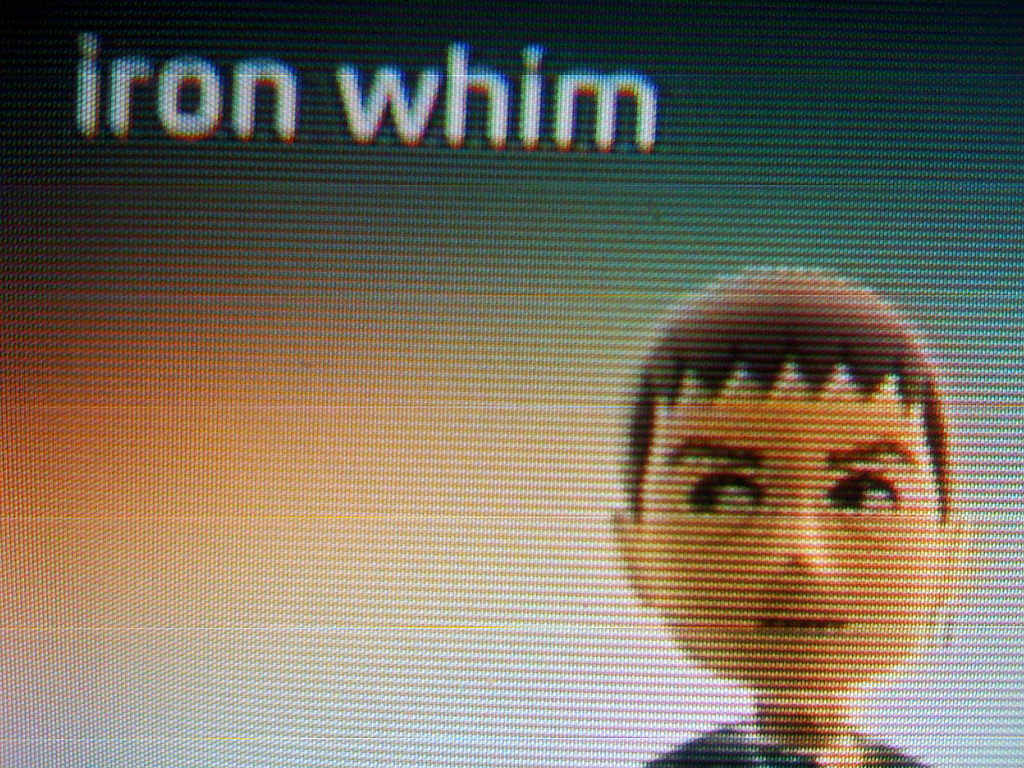On November 19, 2008, Microsoft relaunched the XBox Live Network with a brand-new (bearing in mind that with Microsoft, new is always a relative state of mind) avatar-based interface, and the XBox-based portion of my online identity received an extreme makeover.
“Your avatar,” writes Microsoft, “is your game face throughout the New Xbox Experience and represents your personality, whether you are serving as an Xbox LIVE Party host, playing a game of Scene It?® Box Office Smash, or chatting with a friend.” Never mind that I liked the Blades interface better; it’s gone like a Spice Girls lunchbox is gone. So let’s come to grips with the notion that an ostensibly adorable, vaguely asexual and notably creepy digital puppet now “represents my personality.”
As the pictures above (snapped off my TV) demonstrate, the best that the XBox avatar construction kit can do is to make me look like a virtual Pinocchio. Like the original, pre-Disney wooden boy, who was, by all accounts, kind of an asshole, this Mini-Me is not particularly pleasant. In fact, I’d go so far as to say that this little avatar is a full-fledged citizen of the uncanny valley.
First postulated by Masahiro Mori in 1970, the Uncanny Valley is an hypothesis about what happens to human emotional response as robots become increasingly lifelike in appearance. For Mori, our positive emotional response to anthropormorphism peaks just before resemblance to the human becomes accurate — with stuffed animals and Wall-E, for example. After that point, though, as resemblance becomes stronger, there’s a noticeable change in perception. Revulsion sets in as machines become too lifelike. If you graph this relationship, the fall-off in positive emotional response to increasingly lifelike machines forms a trough, i.e. the aforementioned Uncanny Valley. As Slavoj Žižek has noted, too much life is a bad thing — the Uncanny Valley is populated with zombies, vampires, Terminators and other nightmares that have no business being alive. The little monster capering around my XBox interface is no exception.
Evidently, though, Microsoft is successfully backfilling the more worrisome trenches of the Uncanny Valley and tamping it all down nice and smooth. Gamasutra reported in early December that since the launch of the New XBox Live Experience, sales have tripled. In paricular, the game A Kingdom for Keflings, one of the first games that gives you the choice of playing as your avatar, registered the second-best debut performance ever on the service.
Other than the blatant attempt to pooch Nintendo’s look and feel in the interest of interpellating you directly into the XBox brand instead of relying on external (possibly unlicensed!) products to establish your sense of subjectivity, I can see little rationale for the new XBox avatars. Mimetic realism in video games has no relationship to fun; in most cases, it usually inhibits playability. The recent reemergence of classic arcade games like Tempest, Missile Command and Galaga, usually in both “classic” and “rebooted” form, plus the astonishing success of the Geometry Wars (“Retro Evolved”) franchise, feels like a lesson that’s been entirely lost.
Mimesis in video games seems to culminate with two highly rendered figures hammering away at each other in a close-quarters, button-mashing frenzy (viz. Soul Calibur IV or any other descendants of Street Fighter). In other words, when the emphasis falls on rendering rather than gameplay, the experience of a virtual world narrows down to a bloody ring drawn on the floor of an arena. Or, alternatively, it might be an alien hooch-club stage populated entirely by dancing penis monsters, which is amusing in the short term, but ultimately just as tedious.
I’m not advocating a return to Pong, mind you. You’ll have to pry my copy of The Orange Box out of my cold, dead fingers. But I would like to leave a little something about the way I present myself to the imagination. Why can’t I be a robot, a bug, a fish, a superintelligent shade of the colour blue? The easiest way to do that is with a humble, two-dimensional portrait in the corner of the screen.






